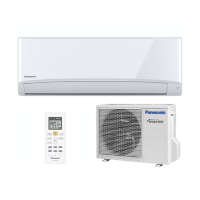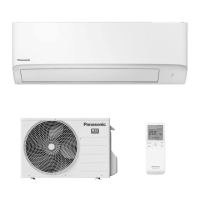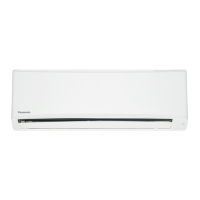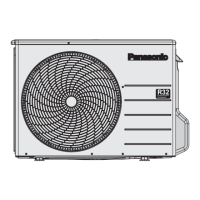Why is my Panasonic CS-TZ20ZKEW remote control not working?
- VVictor RoseAug 7, 2025
If the remote control for your Panasonic Air Conditioner is not working, ensure the batteries are inserted correctly and replace weak batteries.
Why is my Panasonic CS-TZ20ZKEW remote control not working?
If the remote control for your Panasonic Air Conditioner is not working, ensure the batteries are inserted correctly and replace weak batteries.
What to do if my Panasonic CS-TZ20ZKEW doesn't receive the remote control signal?
If the Panasonic Air Conditioner unit does not receive the signal from the remote control, ensure that the receiver is not obstructed. Note that certain fluorescent lights may interfere with the signal transmitter; consult an authorised dealer.
How to improve the efficiency of HEAT/COOL mode on my Panasonic CS-TZ20ZKEW Air Conditioner?
If your Panasonic Air Conditioner isn't operating efficiently in HEAT/COOL mode, make sure you've set the temperature correctly. Close all doors and windows, clean or replace the filters, and clear any obstructions at the air inlet and outlet vents.
Instructions for inserting AAA or R03 batteries into the remote control.
Steps to set the current time on the remote control.
Instructions on how to turn the unit on or off using the power button.
Guide to selecting modes like AUTO, HEAT, DRY, or COOL.
How to set the desired temperature using UP and DOWN buttons.
Important warnings and cautions for operating the indoor and outdoor units.
Safety instructions regarding the use of the remote control.
Precautions related to the power supply cord, plug, and earthing.
Cautions for handling the indoor and outdoor units, including cleaning and installation.
Safety guidelines for remote control use.
Specific safety measures when working with R32 refrigerant.
Checks and procedures for refrigerating equipment.
Guidelines for installing the unit in appropriate spaces, considering refrigerant safety.
Qualifications and responsibilities of service personnel handling refrigerants.
Safety checks and procedures to minimize ignition risks during work.
Ensuring correct specifications and condition of refrigerating equipment.
Safety checks for electrical components during repair and maintenance.
Safety measures during repairs to sealed components.
Acceptable methods for detecting flammable refrigerant leaks.
Steps for safely removing and evacuating refrigerant from the system.
Guidelines for safely charging the system with refrigerant.
Steps and precautions for safely decommissioning the air conditioner.
Best practices for recovering refrigerant into cylinders.
Avoiding mixing refrigerants in recovery units and cylinders.
How to adjust the horizontal and lateral airflow direction of the unit.
Settings for fan speed, AUTO fan, and QUIET operation.
Using the nanoe X feature for air purification and moisturization.
Activating the POWERFUL mode for rapid temperature adjustment.
Using the MILD DRY mode to reduce air dryness.
Details on the SLEEP operation for a comfortable sleeping environment.
Instructions for setting the ON/OFF timer for the unit.
Information on setting up the Wireless LAN Module for remote control.
Explanation of different operating modes like AUTO, HEAT, COOL, and DRY.
Recommended temperature ranges for energy saving in HEAT and COOL modes.
How the horizontal flap adjusts for different modes.
How the unit restarts automatically after a power failure.
Table indicating recommended operating temperature ranges for indoor and outdoor units.
Instructions for cleaning the indoor unit surface and front panel.
How to clean the outdoor unit and clear drain pipe blockages.
Guidance on cleaning and replacing air filters.
Causes for the POWER indicator blinking before or during operation.
Explanation for the TIMER indicator remaining illuminated.
Reasons for delayed restarts and reduced cooling/heating capacity.
Causes for indoor fan stopping or behavior during different modes.
Common noises, odors, and water/steam emissions during operation.
Checks for inefficient HEAT/COOL mode operation and noisy unit.
Troubleshooting steps for a non-functional remote control.
Checks for when the unit does not operate or receive signals.
Steps to operate the unit when the remote control is missing or faulty.
How to adjust the brightness of the unit's indicators.
Checks to perform after a period of non-use.
Steps to take when the unit will not be used for an extended period.
Procedure to access and display error codes using the remote control.
List of diagnostic codes and their corresponding abnormality/protection controls.
Guidelines for responsible disposal of old equipment and batteries.
Explanation of symbols used in the manual, including warnings and information indicators.
Instructions for inserting AAA or R03 batteries into the remote control.
Steps to set the current time on the remote control.
Instructions on how to turn the unit on or off using the power button.
Guide to selecting modes like AUTO, HEAT, DRY, or COOL.
How to set the desired temperature using UP and DOWN buttons.
Important warnings and cautions for operating the indoor and outdoor units.
Safety instructions regarding the use of the remote control.
Precautions related to the power supply cord, plug, and earthing.
Cautions for handling the indoor and outdoor units, including cleaning and installation.
Safety guidelines for remote control use.
Specific safety measures when working with R32 refrigerant.
Checks and procedures for refrigerating equipment.
Guidelines for installing the unit in appropriate spaces, considering refrigerant safety.
Qualifications and responsibilities of service personnel handling refrigerants.
Safety checks and procedures to minimize ignition risks during work.
Ensuring correct specifications and condition of refrigerating equipment.
Safety checks for electrical components during repair and maintenance.
Safety measures during repairs to sealed components.
Acceptable methods for detecting flammable refrigerant leaks.
Steps for safely removing and evacuating refrigerant from the system.
Guidelines for safely charging the system with refrigerant.
Steps and precautions for safely decommissioning the air conditioner.
Best practices for recovering refrigerant into cylinders.
Avoiding mixing refrigerants in recovery units and cylinders.
How to adjust the horizontal and lateral airflow direction of the unit.
Settings for fan speed, AUTO fan, and QUIET operation.
Using the nanoe X feature for air purification and moisturization.
Activating the POWERFUL mode for rapid temperature adjustment.
Using the MILD DRY mode to reduce air dryness.
Details on the SLEEP operation for a comfortable sleeping environment.
Instructions for setting the ON/OFF timer for the unit.
Information on setting up the Wireless LAN Module for remote control.
Explanation of different operating modes like AUTO, HEAT, COOL, and DRY.
Recommended temperature ranges for energy saving in HEAT and COOL modes.
How the horizontal flap adjusts for different modes.
How the unit restarts automatically after a power failure.
Table indicating recommended operating temperature ranges for indoor and outdoor units.
Instructions for cleaning the indoor unit surface and front panel.
How to clean the outdoor unit and clear drain pipe blockages.
Guidance on cleaning and replacing air filters.
Causes for the POWER indicator blinking before or during operation.
Explanation for the TIMER indicator remaining illuminated.
Reasons for delayed restarts and reduced cooling/heating capacity.
Causes for indoor fan stopping or behavior during different modes.
Common noises, odors, and water/steam emissions during operation.
Checks for inefficient HEAT/COOL mode operation and noisy unit.
Troubleshooting steps for a non-functional remote control.
Checks for when the unit does not operate or receive signals.
Steps to operate the unit when the remote control is missing or faulty.
How to adjust the brightness of the unit's indicators.
Checks to perform after a period of non-use.
Steps to take when the unit will not be used for an extended period.
Procedure to access and display error codes using the remote control.
List of diagnostic codes and their corresponding abnormality/protection controls.
Guidelines for responsible disposal of old equipment and batteries.
Explanation of symbols used in the manual, including warnings and information indicators.
This document provides operating instructions for a Panasonic air conditioner, covering its functions, usage, and maintenance.
The Panasonic air conditioner is designed to provide comfortable indoor climate control. It offers both single split and multi split system configurations, allowing for flexible installation to suit various needs. A notable feature is the built-in Network Adaptor, which enables remote control of the heat pump from anywhere, enhancing convenience and accessibility. The unit operates with R32 refrigerant, a mild flammable refrigerant, and includes specific safety precautions related to its handling and installation.
The air conditioner supports various operation modes:
The unit also incorporates energy-saving temperature settings, recommending specific ranges for HEAT (20.0 °C ~ 24.0 °C / 68 °F ~ 75 °F) and COOL (26.0 °C ~ 28.0 °C / 79 °F ~ 82 °F) modes to optimize energy consumption.
The air conditioner is controlled via a remote control, which should be used within 8 meters of the indoor unit's receiver.
Basic Operation:
Clock Setting:
Airflow Direction:
Fan Speed and Quiet Operation:
Fresher and Cleaner Environment (nanoe™ X):
Quick Temperature Reach (POWERFUL):
Humidity and Moisture Level Improvement (MILD DRY - Not applicable for Multi split system):
Sleep Mode:
Timer Setting:
Auto Restart Control:
Wireless LAN Module:
Regular cleaning is crucial for optimal performance and to prevent malfunctions, such as the "H 99" error code.
General Precautions:
Indoor Unit Cleaning:
Outdoor Unit Cleaning:
Seasonal Inspection (after extended non-use):
Extended Non-Use Preparation:
Troubleshooting:
| Heating Capacity | 2.5 kW |
|---|---|
| Refrigerant | R32 |
| Energy Efficiency Class (Cooling) | A++ |
| Energy Efficiency Class (Heating) | A+ |
| Mounting | Wall Mounted |
| Cooling Capacity | 2 kW |
| SCOP | 4.0 |
| Noise Level (Indoor) | 19 dB (Low) |
| Coefficient of Performance (COP) | 4.0 |












